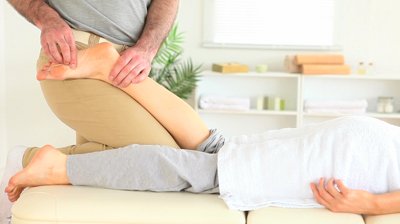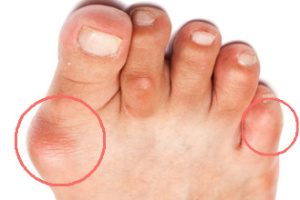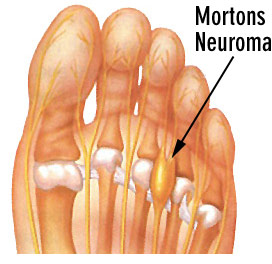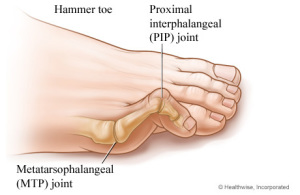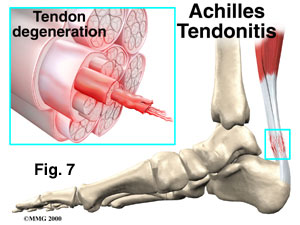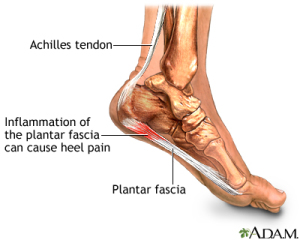Bunions/hallux valgus
A bunion is an enlargement of bone or tissue around the joint at the base of the big toe (metatarsophalangeal joint).The big toe (hallux) may turn in toward the second toe (angulation), and the tissues surrounding the joint may be swollen and tender.
The term “hallux valgus” is the most commonly used medical term associated with a bunion anomaly, where “hallux” refers to the big toe; “valgus” refers to the abnormal angle of the big toe commonly associated with bunion anomalies.
The symptoms of bunions include irritated skin around the bunion, pain when walking, joint redness and pain, and possible shift of the big toe toward the other toes. Blisters and or calluses may form more easily around the site of the bunion as well.
Having bunions can also make it harder to find shoes that fit properly. Bunions may force a person to have to buy a larger size shoe to accommodate the width the bunion creates. When bunion deformity becomes severe enough, the foot can hurt in different places even without the constriction of shoes as it then becomes a mechanical function problem of the forefoot.
Chiropractic and Active Release Technique (ART):
Chiropractic adjustments will restore motion to restricted joints of the foot/toes. Often with bunions, the big toe tendons are tight and adhesed. Dr. Rodwin would use the active release technique to release the tendon tightness/scar tissue. A postural and dynamic gait assessment will identify any biomechanical deficiencies that may be helped with custom orthotics.
Custom Orthotics:
At Back to Health we offer high-quality custom made orthotics to help reduce the effects caused by improper foot function. Custom orthotics can be designed to stabilize the bunions and prevent a worsening of the condition. Bunions can also result from a functional problem in the forefoot. We can detect this with the gait analysis if this is likely to occur. If caught early, we may be able to prevent bunions from forming at all.
Arch Pain or Plantar Fasciitis
Plantar fasciitis is characterized by pain on the sole of the foot, especially in the heel at the hind foot. It can also be symptomatic all the way up the arch. It is caused when the fascia becomes torn, inflamed or over-stretched. It is often precipitated by an acute injury, prolonged or excessive pronation, a high arch, or even a change in footwear. Typically, the discomfort is more noticeable first thing in the morning after getting out of bed, or after sitting for awhile and then standing.
Chiropractic:
Treatment may include prescribed orthotics and soft tissue techniques. The doctor of chiropractic assesses the biomechanics of the foot. A gait analysis also helps to determine whether custom orthotics would be beneficial. Soft tissue techniques such as the Active Release Technique (ART) are used to break-up scar tissue in the foot and compensating part of the lower legs.
Massage Therapy:
Short-term goals of massage therapy are to reduce pain and inflammation, as well as increase drainage and circulation to the compromised tissue. Muscles of the lower leg will also be addressed for tightness and to maintain range of motion. Long-term goals include eliminating irritating adhesions and restoring proper biomechanics to the foot.
Custom Orthotics:
Custom orthotics are often recommended with plantar fasciitis. The plantar fascia is often under strain with excessive pronation (fallen arches), as well as with a lack of shock absorption at heel strike. A gait analysis will confirm whether this method of treatment is warranted.
Fallen Arches/Excessive Pronation
Excessive pronation affects 85% of people with abnormal foot mechanics. It occurs when the foot pronates too much or for too long and does not return to its neutral position during the foot flat or mid-stance phase of gait (walking or running movements). Excessive pronation is often associated with flat feet or low arches.
Excessive pronators may suffer from a number of overuse syndromes:
plantar fasciitis (inflammation of the tissues under the heel and arch, sometimes leading to heel spurs)
Achilles tendonitis (inflammation behind the ankle and bottom of the calf muscles)
shin splints (inflammation at the bone-tendon junction at the front or back of the shin bone or tibia)
patellar (kneecap) tendonitis
iliotibial band syndrome (tightness and inflammation of the tendonous sheet at the outside of the knee)
patellofemoral syndrome (inflammation and abnormal wear between the knee joint and the covering kneecap)
Custom Orthotics
At Back to Health, we offer high-quality custom orthotics to help reduce the effects caused by improper ankle and foot function. During improper foot and ankle movement, the wrong muscles contract, or they contract out of their proper, critical sequence. Your muscles and tendons eventually fatigue and break down, suffering microscopic tears. This triggers inflammation, leading to swelling, pain, and scarring in these tissues. As well, your joints may suffer excess wear, leading to inflammation and possibly degeneration. Consequently, pain and dysfunction may arise in your feet, ankles, legs, knees, thighs, hips, low back, and further “up the chain.”
Fallen arches/overpronation
Overpronation affects 85% of people with abnormal foot mechanics. It occurs when the foot pronates too much or for too long and does not return to its neutral position during the foot flat or mid-stance phase of gait (walking or running movements). Overpronation is often associated with flat feet or low arches.
Overpronators may suffer from a number of overuse syndromes:
plantar fasciitis (inflammation of the tissues under the heel and arch, sometimes leading to heel spurs)
Achilles Tendonitis (inflammation behind the ankle and bottom of the calf muscles)
shin splints (inflammation at the bone-tendon junction at the front or back of the shin bone or tibia)
patellar (kneecap) tendonitis
Iliotibial Band Syndrome (tightness and inflammation of the tendonous sheet at the outside of the knee)
Patellofemoral Syndrome (inflammation and abnormal wear between the knee joint and the covering kneecap)
Metatarsalgia
Metatarsalgia is generalized pain underneath the foot in the area of the metatarsals.
Chiropractic:
Chiropractic adjustments will restore motion to restricted joints of the foot. A postural and dynamic gait assessment will identify any biomechanical deficiencies that may be helped with custom orthotics.
Custom Orthotics:
Custom orthotics are often warranted to aid in the resolution of metatarsal pain. The transverse or metatarsal arches have usually dropped when these symptoms arise. Therefore, the metatarsal bones are closer to the ground and need to be lifted. Lifting is added to the orthotics to alleviate pressure on those joints (bones). Another solution can be to add an adhesive metatarsal pad to the footwear. The orthotic consultant will complete this assessment in our clinic.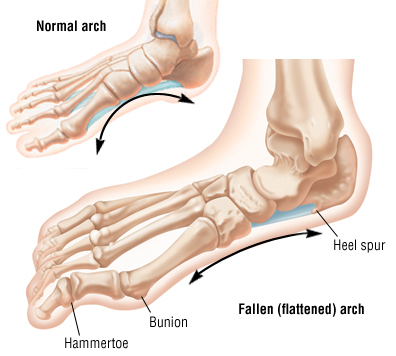
Morton’s Neuroma
Morton’s neuroma is a thickening of nerve tissue between the toes. It commonly affects the nerve that travels between the third and fourth toes. Morton’s neuroma symptoms can also result from dropped metatarsal bones/arch in the forefoot. This dropping puts pressure on the nerve and gives Morton’s neuroma symptoms in the feet.
Morton’s neuroma is more common in women than men. The exact cause is unknown. However, some experts believe the following may play a role in the development of this condition:
Abnormal positioning of toes
Flat feet or excessive pronation
Forefoot problems, including bunions and hammer toes, fallen transverse/metatarsal arches
High arches or rigid acting feet
Tight shoes and high heels
Symptoms of Morton’s neuroma include:
Tingling in the space between the third and fourth toes
Toe cramping
Sharp, shooting, or burning pains in the ball of your foot (and sometimes toes)
Pain that increases when wearing shoes or pressing on the area
Pain that gets worse over time
In rare cases, nerve pain occurs in the space between the second and third toes. This is not a common form of Morton’s neuroma, but treatment is similar.
Treatment options:
Metatarsal padding under the dropped area to lift and splay between the toes.
Custom orthotics to support the fallen longitudinal and metatarsal/transverse arch. Depending on the symptoms, a “neuroma pad” can be added to the orthotic. This is a bar-shaped padding added between the two specific metatarsal heads to spread these and take pressure of the nerve running between them.
Changes to footwear (for example, shoes with wider toe boxes)
Chiropractic and Active Release Technique
Chiropractic adjustments will restore motion to restricted joints of the foot. Active Release Technique (ART) is also administered to the tight, adhesed muscles in the feet. A postural and dynamic gait assessment will identify any biomechanical deficiencies that may be helped with custom orthotics or the addition of metatarsal pads.
Toe Deformities (claw toe, hammer toe, mallet toe)
Toe deformities may result from arthritis, and from bone and muscle imbalances.
Chiropractic:
Chiropractic adjustments will restore motion to restricted joints of the foot. A postural and dynamic gait assessment will identify any biomechanical deficiencies that may be helped with custom orthotics.
Custom Orthotics:
With toe deformities, there is improper forefoot loading or biomechanics. The gait analysis and consultation will identify where these problems are and give advice on custom orthotics and compensatory footwear if required. Occasionally, other orthopaedic devices are recommended, such as toe spacers/separators.
Sprains and Strains
Sprains occur when ligaments are damaged; strains occur when muscles are injured. In reality they often go hand in hand. When a ligament or muscle is injured, the joints in the area are usually affected. During the initial stage of a sprain or strain, rest, ice, elevation, and compression are recommended.
Chiropractic:
Interferential current may be used to relieve the pain and inflammation during the initial stages. As the condition begins to resolve, the doctor of chiropractic will prescribe some exercises to increase the range of motion in the affected joints. When it is appropriate, chiropractic adjustments will be applied to the joints to restore proper motion and function. Soft tissue techniques, such as ART (Active Release Technique) and trigger point therapy are also used to break up scar tissue and relax surrounding musculature.
Acupuncture:
Acupuncture, in conjunction with other treatments, speeds up the healing process, and decreases inflammation. Acupuncture does this by stimulating the natural release of endorphins, which are the body’s natural pain killers. Dr. Rodwin is a certified acupuncturist and will recommend this method of treatment if it is warranted.
Massage Therapy:
Massage therapy is important in reducing the inflammation by increasing drainage and circulation to the injury. Massage will decrease pain by reducing the spasm in the musculature, and will maintain the range of motion of the involved joints without re-injuring the affected tissue. Massage will also help by eliminating any scar tissue through ART so the joints function optimally.
Achilles Tendonitis
Achilles tendonitis is a condition where the Achilles tendon, at or near its insertion into the heel, becomes inflamed and causes pain.
Chiropractic:
A postural and dynamic gait assessment will identify any biomechanical deficiencies that may be helped with custom orthotics. It is thought that rolling in at the feet puts excessive pressure on the tendon of the gastrocnemius muscle, causing Achilles Tendonitis.
Massage Therapy:
Massage therapy will decrease inflammation and reduce irritating adhesions. Massage will reduce muscle spasms and trigger points, helping to maintain a full range of motion.
Active Release Technique (ART):
Both Dr. Rodwin and our registered massage therapists are certified in the Active Release Technique (ART). This treatment breaks up adhesions/scar tissue that may be present in the tendon or even the calf muscles. These adhesions prevent a muscle from functioning efficiently, which can lead to a chronic injury.
Acupuncture:
Acupuncture, in conjunction with other treatments, speeds up the healing process and decreases inflammation. Acupuncture does this by stimulating the natural release of endorphins, which are the body’s natural pain killers. Dr. Rodwin is a certified acupuncturist and will recommend this method of treatment if it is warranted.
Custom Orthotics:
A gait analysis can determine whether the Achilles tendon injury is caused by, or due in part to, a biomechanical imbalance in the feet. If this is the case, custom orthotics or heel cushions may be advised to aid in the resolution of the complaint.
Heel Pain/Heel Spurs/Plantar Fasciitis
Plantar fasciitis is characterized by pain on the sole of the foot, especially in the heel at the hind foot. It is caused when the fascia becomes torn, inflamed or over-stretched. It is often precipitated by an acute injury, prolonged or excessive pronation, a high arch, or even a change in footwear. Typically, the discomfort is more noticeable first thing in the morning after getting out of bed. Prolonged, untreated plantar fasciitis can lead to the development of a heel spur. The tightness in the plantar fascia causes strain on the bony structure of the heel. This tightness eventually can cause a pulling away of the bone, thus creating a spur.
Chiropractic:
Treatment may include prescribed custom orthotics and soft tissue techniques. The doctor of chiropractic assesses the biomechanics of the foot and determines whether orthotics would be beneficial. Soft tissue techniques, such as ART, are used to break up scar tissue in the area.
Massage Therapy:
Short-term goals of massage therapy are to reduce pain and inflammation, as well as increase drainage and circulation to the compromised tissue. Muscles of the lower leg will also be addressed for tightness and to maintain range of motion. Long-term goals include eliminating irritating adhesions and restoring proper biomechanics to the foot.
Custom Orthotics:
Custom orthotics can be designed to unload the heel spur. The orthotics correct the improper alignment, which may have led to the plantar fascia being under strain. Orthotics also cushion and unload the spur itself. This unloading will alleviate the heel pain experienced with use.

